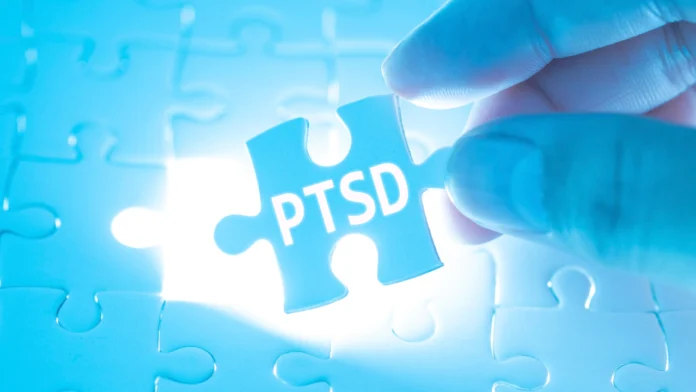Living with post traumatic stress disorder can be difficult to navigate. PTSD is not just stress or anxiety. It can significantly impact a person’s entire wellbeing. By understanding what PTSD means, what PTSD symptoms are, and what treatment options are available, you can start to heal and take control of your life again.
Therapy.com is user supported. We receive a commission fee from purchases made through BetterHelp links.
Learn More
What Is PTSD?
Post traumatic stress disorder is a mental health condition that can develop after experiencing, witnessing, or learning about a traumatic event. But what does PTSD mean? PTSD can occur when the brain continues to respond to trauma long after it’s over, impacting emotions, memory, and everyday life.
Clinically, PTSD is considered a trauma disorder and is classified under trauma- and stressor-related disorders in the ICD-10 (International Classification of Diseases) and the DSM-5-TR (Diagnostic and Statistical Manual of Mental Disorders).
A Brief History of PTSD
PTSD has a long history. It’s been recognized and documented for centuries under varying names. Historically, PTSD symptoms were seen in veterans and military members and referred to as “shell shock” during World War I and “combat stress reaction” during World War II.
Our understanding of PTSD has shifted over time due to research. Processes for diagnosis and treating PTSD have evolved as well.
Research has shown that PTSD can affect anyone who experiences trauma and not just soldiers. Once classified as an anxiety disorder PTSD’s wide symptom range and origins in trauma support its reclassification as a disorder linked to trauma and severe stressors.
The Neurobiological Basis of PTSD
PTSD is not only psychological but also biological, because it impacts the brain and nervous system. Experiencing trauma changes a person’s brain structure and functioning. The neurobiological systems involved in the development of post traumatic stress disorder include:
Amygdala: This is responsible for how we perceive fear and process emotions. In PTSD, the amygdala is hyper-aroused by stimuli that cause intense fear. The fear response may be accompanied by other significant and negative emotions, such as severe grief.
Hippocampus: The hippocampus is responsible for memory and understanding of situations and environment. In PTSD, the brain misinterprets safe situations as threatening or dangerous.
Prefrontal Cortex: The prefrontal cortex is responsible for logical thinking and the ability to control emotions. In PTSD, this reduces, making it more difficult to differentiate between real threats and false alarms.
These significant biological changes are why PTSD symptoms can feel like they’re beyond your control. And this is also why it’s so important to understand the neurobiological origins of your PTSD symptoms.
PTSD Prevalence
PTSD affects millions worldwide but rates vary depending on the population. Around 6% U.S. adults will experience PTSD in their lifetime.
It’s also estimated that 5.0% of teenagers between the ages of 13 and 18 have experienced PTSD. Income, location, and conflict exposure also are shown to impact PTSD prevalence.
Gender differences show that women tend to develop PTSD more often than men, and women also suffer from PTSD longer than men. Up to a third of veterans, first responders, and survivors of severe trauma, such as rape, military combat, or genocide, will develop PTSD.
Racial differences also exist, where Latino, African American, and American Indian populations in the U.S. have higher rates than White individuals. Past struggles, racism, discrimination, financial struggles, poor access to help, and inadequate support can affect how likely someone is to develop PTSD and how well they recover.
Common Misconceptions of PTSD
There are many common misconceptions about PTSD. One is that only soldiers get PTSD but that’s not true. Anyone who has had a traumatic experience can develop it.
Another misunderstanding is that PTSD is a sign of weakness. In reality, PTSD is a normal reaction to an abnormal traumatic experience and does not reflect a person’s strength or resilience.
Therapy.com is user supported. We receive a commission fee from purchases made through BetterHelp links.
Learn More
Many also believe that PTSD symptoms must occur immediately after a traumatic event. However, the onset of PTSD may occur months or even years after the event. However, PTSD typically emerges within three months of the trauma.
PTSD symptoms often develop gradually and intermittently, with episodes of remission and recurrence. You can’t be diagnosed until you’ve experienced at least a month of persistent symptoms.
How PTSD Differs From Normal Stress Responses
The primary differences between PTSD and the normal stress response are time and impact. Normal stress responses, such as fear, anxiety, hypervigilance, and hyperreactivity, subside almost immediately after the threat (real or perceived) has passed.
In PTSD, these stress responses are activated even when no danger is present. The brain misinterprets environmental cues as signs of threat, activating the fight or flight response. This ultimately can have a severe and lasting impact across all domains of a person’s life, including their ability to work, attend school, engage in social functions, and maintain relationships.
Unlike a normal stress response, PTSD can cause a person to self-isolate to avoid symptom triggers. They may also self-medicate with drugs or alcohol to alleviate their anxiety and depression.
Signs and Symptoms
Early recognition of PTSD warning signs can help prevent symptoms from worsening. There are four main categories of PTSD symptoms:
- Re-experiencing symptoms: Flashbacks, intrusive memories, nightmares and upsetting thoughts
- Avoidance symptoms: Avoiding people, places, or activities that remind you of the traumatic event
- Negative changes in mood & cognition: Feelings of hopelessness, guilt, emotional numbness and struggling with relationships
- Hyperarousal symptoms: Being easily irritated, trouble sleeping, getting easily startled and difficulty concentrating
Triggers and Flashbacks
Post traumatic stress disorder can trigger or bring back bad memories of the trauma. Triggers can be inside the body, remembering sensations or emotional distress, or outside the body such as hearing loud noises, particular smells or being in a place that reminds one of the traumatic event.
Triggers may lead to flashbacks. A flashback is an intense memory that can feel like the trauma is happening again. This strong memory can feel like a daydream or it may become so intense that you feel completely disconnected from the present reality. In some cases, you may feel like you’ve been transported back to the original traumatic event, reliving it through all the senses.
Other PTSD symptoms include:
- Physical symptoms: Chronic pain, fatigue, stomach issues, headaches
- Cognitive symptoms: Memory problems, difficulty focusing, intrusive thoughts
- Emotional symptoms: Anxiety, depression, feeling disconnected from others
- Behavioral signs: Social withdrawal, reckless behavior
- Sleep disturbances: Insomnia, recurring nightmares
How Symptoms May Manifest Differently Across Age Groups
PTSD can happen anytime after the first year of life. However PTSD symptoms may be expressed differently depending on a person’s age and current development:
Children
PTSD symptoms look different for children 6 years old and under. Play is often used to express or reenact trauma, as children cannot verbalize the same as adults. Caregivers and parents need to notice any changes in the child’s behavior or emotions. Children may withdraw, become clingy or have developmental regressions, such as sudden bed wetting.
Adolescents & School-Age children
PTSD shows up similar to adults in this age group, but symptoms may be expressed differently. In younger children, nightmares and sleep issues can be more prominent. Avoidance, such as not trying new activities, isolation, or peer struggles can occur.
In teens, reckless behaviors, increased irritability and aggression may appear. Reluctance with age-appropriate activities, such as learning to drive, and a loss of interest in goals or future plans can appear.
Adults and Seniors
PTSD symptoms in this age group can exacerbate other common health, cognitive, and social functions. This may look like increased doctor’s visits, negative thoughts, and in severe cases, suicidal thoughts. Older adults are also more vulnerable to worsening or reappearing PTSD symptoms if they’ve experienced trauma previously.
Therapy.com is user supported. We receive a commission fee from purchases made through BetterHelp links.
Learn More
When to Seek Help
If PTSD symptoms last more than a month, interfere with daily functioning, or lead to thoughts of self-harm, it is important to contact professional help. Mental healthcare providers specializing in the treatment of PTSD can help you address the unresolved trauma and rebuild your quality of life.
Complex PTSD vs PTSD
C-PTSD comes from trauma exposure, like childhood abuse or domestic violence, over a long period or multiple traumas. On the other hand PTSD comes from one big trauma. Both conditions have similar symptoms, but some research shows that C-PTSD can involve identity disturbances, emotional dysregulation, and chronic shame.
PTSD is more common in accident survivors, assault victims and veterans. C-PTSD is often seen in long term abuse and trafficking survivors. PTSD treatments include trauma-focused therapy and medication while C-PTSD therapy addresses deeper emotional wounds, attachment issues, and self-worth.
While C-PTSD is recognized as a distinct diagnosis in the ICD-11, it is not currently a formal diagnosis in the DSM-5-TR. Instead, its symptoms are included within PTSD criteria, which can impact diagnosis, treatment planning, and insurance coverage. Due to its complexity, C-PTSD can be harder to diagnose and treat than PTSD.
FAQs
PTSD stands for post traumatic stress disorder, and anyone who experiences a trauma or traumatic event is at-risk for developing it.
PTSD usually comes after one traumatic event, while C-PTSD is from multiple, or ongoing traumatic experiences.
The duration of PTSD symptoms can vary widely, with some people getting better in a few months, while others have symptoms for years or even decades.
PTSD usually develops within three months of the traumatic event. However, symptoms and signs of PTSD can develop years after trauma.
While online PTSD tests can help identify possible symptoms, a mental health professional must make a formal diagnosis. PTSD tests, such as the PTSD Checklist for DSM-5 (PCL-5) and the Clinician-Administered PTSD Scale (CAPS-5), are used by professionals to assess PTSD symptoms and severity.
If someone you love has PTSD, there are many ways to support them. It’s important to learn about trauma reactions, be patient, offer emotional support, and encourage them to seek professional help.
Recovery Strategies and Self Care
Dealing with PTSD takes time, but practicing good habits and learning ways to take care of yourself helps. These include:
- Coping skills: Learning to manage stress and anxiety through techniques such as grounding exercises, mindfulness, and deep breathing
- Managing Triggers: Creating safe spaces and soothing distractions
- Social Support: Reaching out to friends, family, and loved ones
- Lifestyle changes: Regularly exercising, eating a balanced diet, and practicing good sleep hygiene
- Self-compassion: Engaging in positive self-talk, setting realistic expectations, and practicing prayer or meditation
Finding Effective Treatment
PTSD is a challenging but treatable condition. With the right combination of therapy, medication, support, and self-care, healing is possible.
Recommended treatment options include trauma-focused therapies such as EMDR (eye movement desensitization and reprocessing), cognitive processing therapy (CPT), and prolonged exposure therapy (PE).
Medication can help manage symptoms, including changes to mood and sleep. Alternative approaches like yoga, acupuncture, and equine therapy can be helpful.
Digital tools such as mobile apps to help manage symptoms and virtual therapy are available.
Therapy.com is user supported. We receive a commission fee from purchases made through BetterHelp links.
Learn More
C-PTSD treatment should include additional approaches focusing on attachment and self-worth through certain specialized treatments.
Finding the Right Provider
Seeking a trauma-informed therapist is essential. Organizations like the National Center for PTSD and NAMI offer directories for finding PTSD specialists. If you or someone you love is struggling, know that help is available.
Creating a Comprehensive Treatment Plan
Post traumatic stress disorder affects every aspect of a person’s life and this is why a comprehensive treatment plan is so essential. Recovery from PTSD is a multi-faceted process that involves whole-person healing.
This should include the support of mental health and medical professionals, therapists, social service providers and other support systems to ensure your physical, psychological, emotional, spiritual, financial, and social wellbeing.
Support for Families and Loved Ones
No one goes through PTSD alone. Families, friends, and colleagues are also affected by their loved one’s struggle. This is why finding support for families and loved ones is so important. Healthcare teams can offer education and counseling for those affected by a loved one’s PTSD diagnosis.
They can also offer support for families and caregivers to help them maintain their own physical, emotional, and mental health while supporting their loved one’s recovery.
Therapy.com is user supported. We receive a commission fee from purchases made through BetterHelp links.
Learn More




